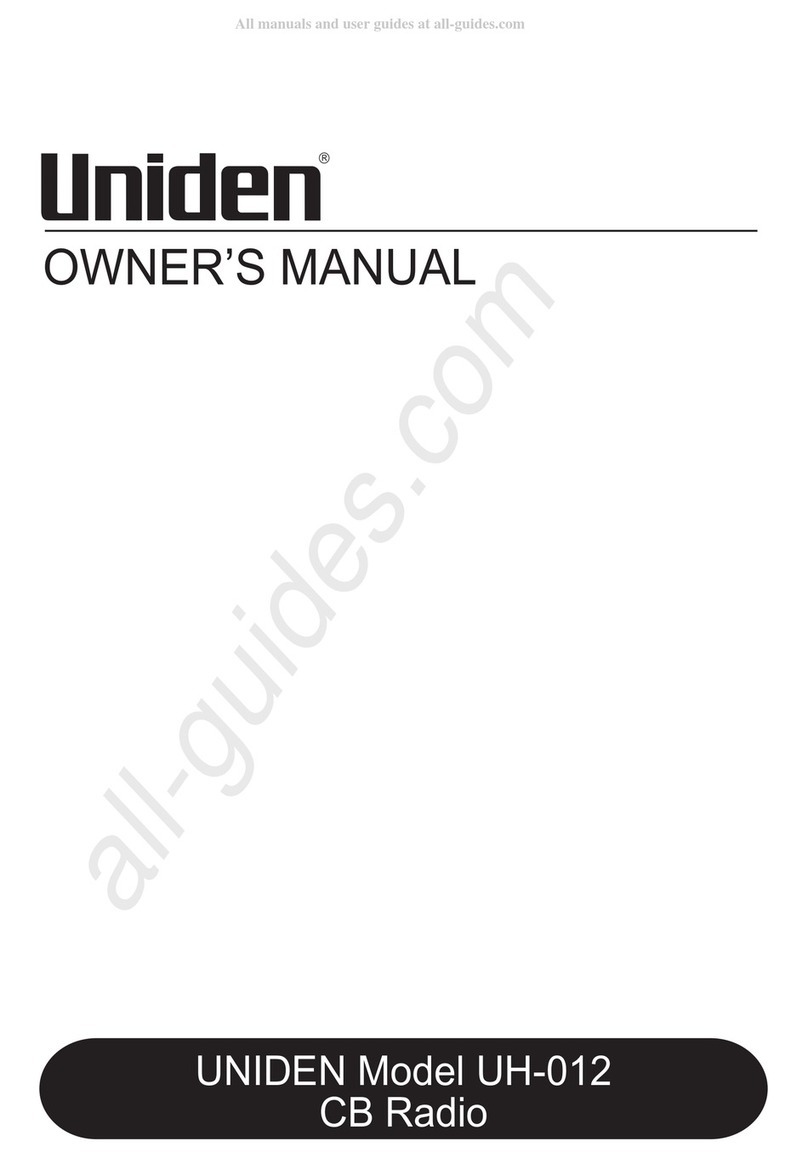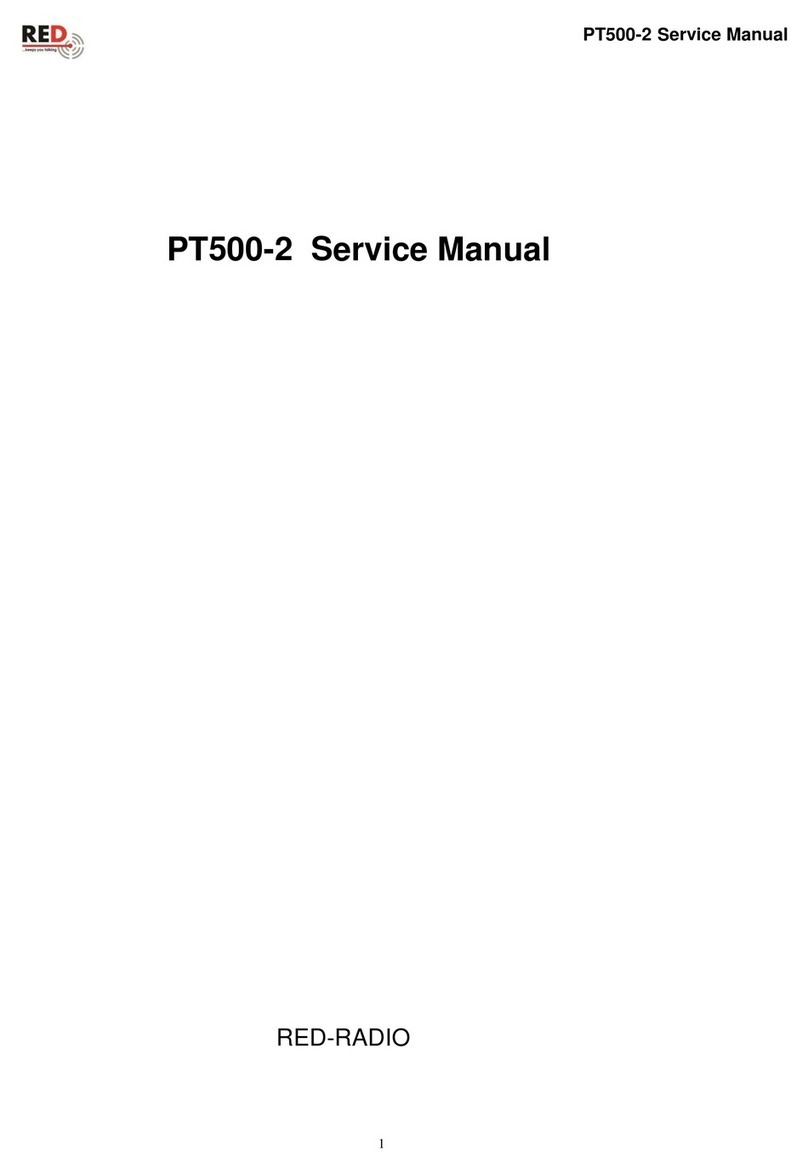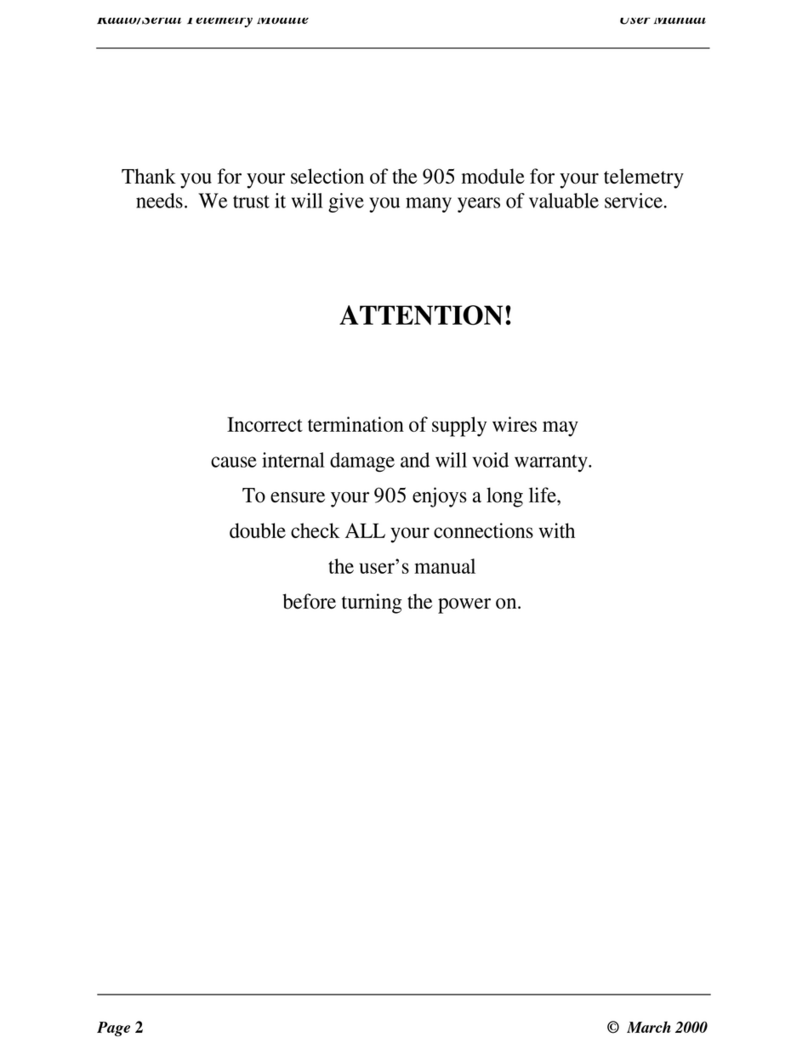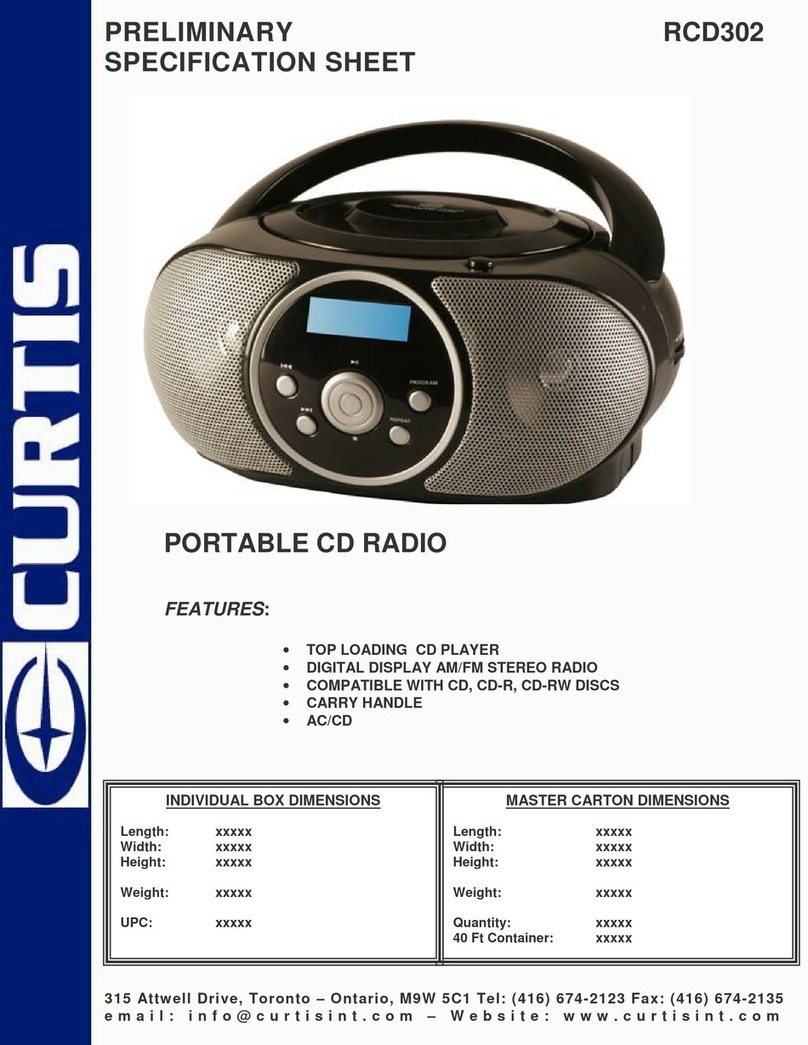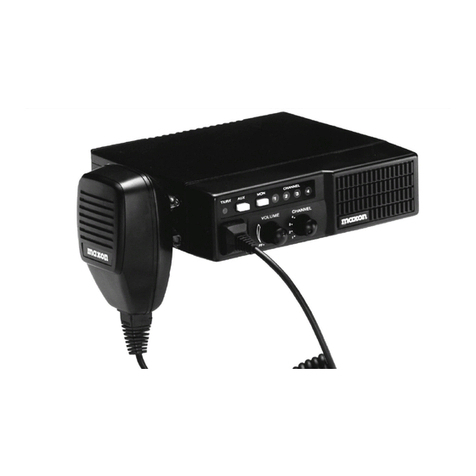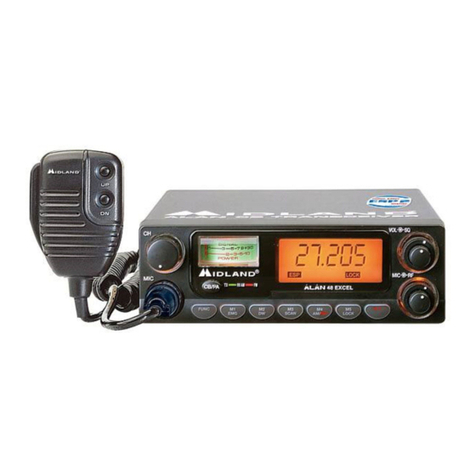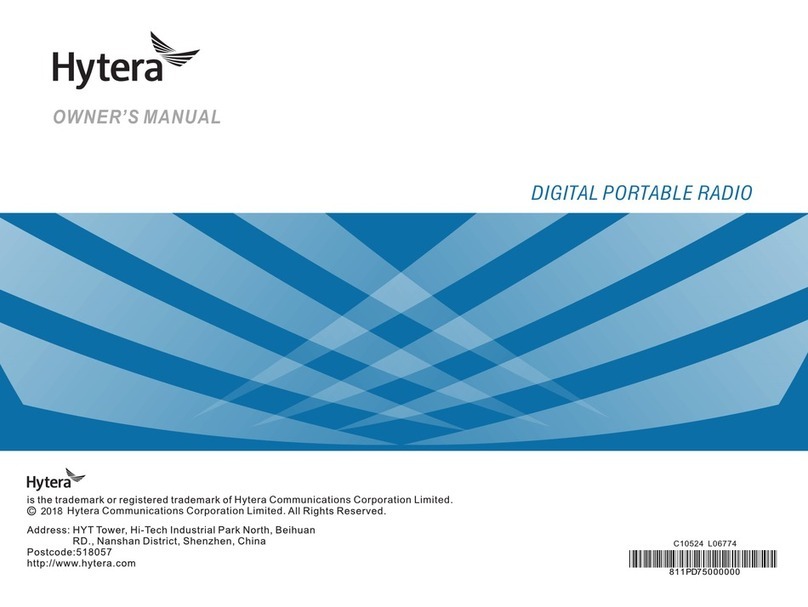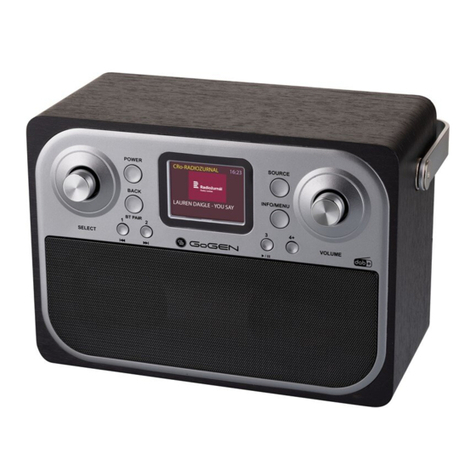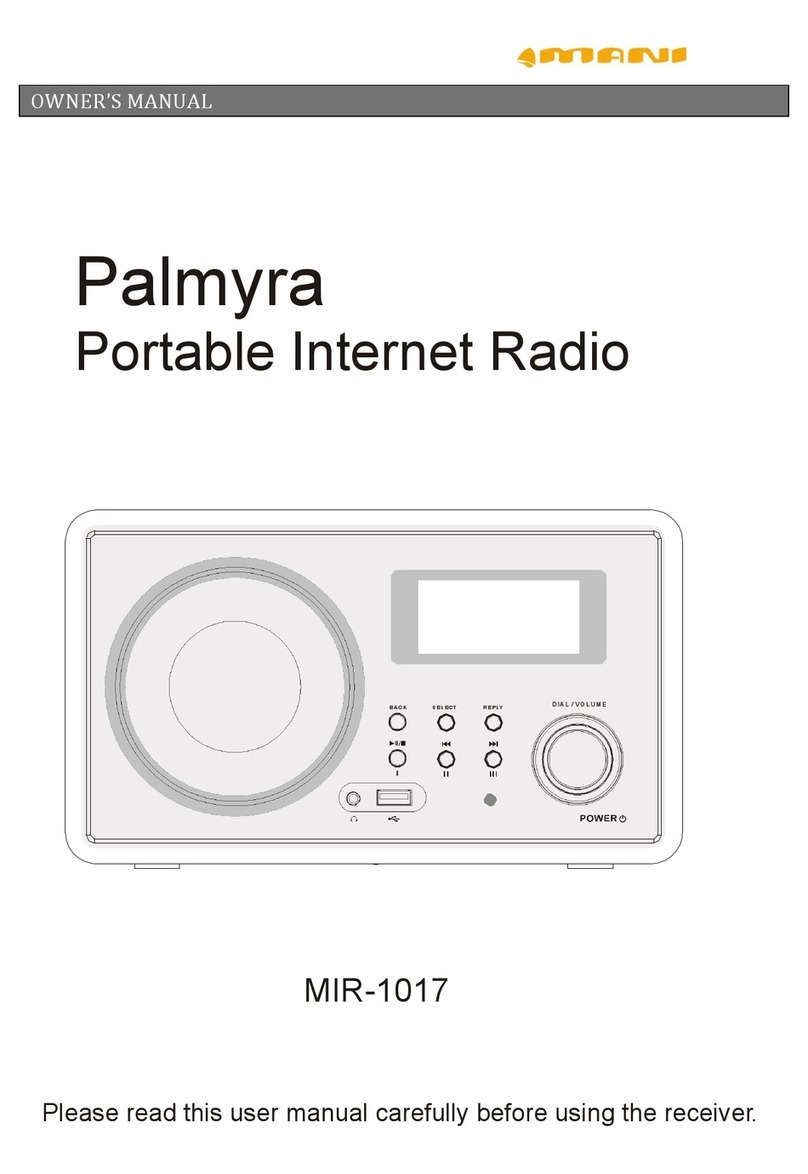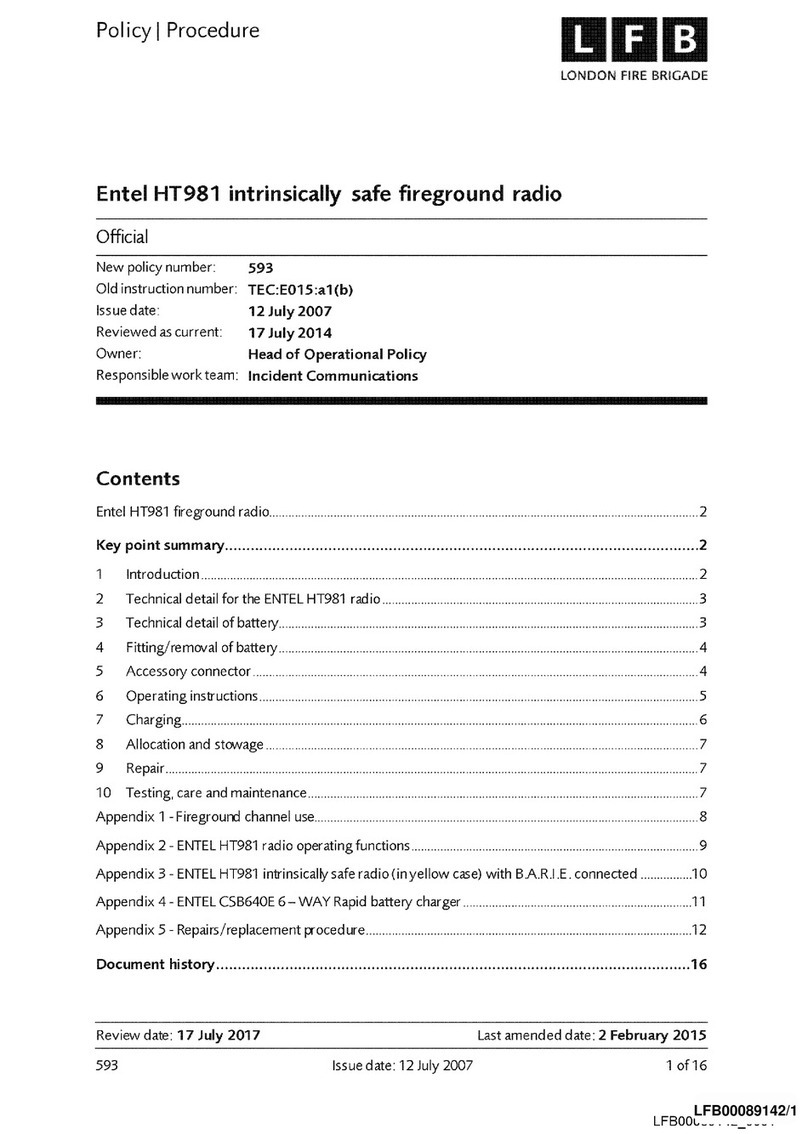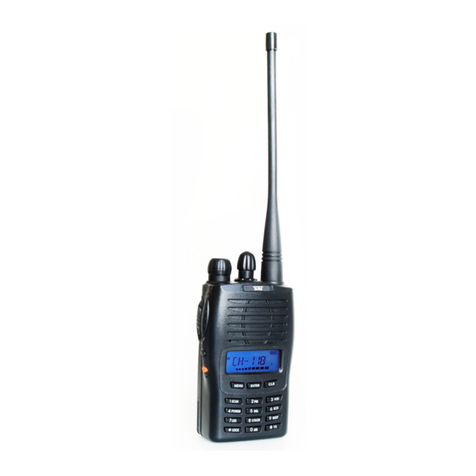Telex TK-80 Series User guide

2018|03
F.01U.321.735 Rev. 02
Kenwood Radio Series
TK-x80, -x90, -x150, and -x180
to IP-224 Remote Adapter Panel

Kenwood Radio Series
2F.01U.321.735 Rev. 02
PROPRIETARY NOTICE
The product information and design disclosed herein were
originated by and are the property of Bosch Security Systems, Inc.
Bosch reserves all patent, proprietary design, manufacturing,
reproduction, use and sales rights thereto, and to any article
disclosed therein, except to the extent rights are expressly granted
to others.
COPYRIGHT NOTICE
Copyright 2018 by Bosch Security Systems, Inc. All rights
reserved. Reproduction, in whole or in part, without prior written
permission from Bosch is prohibited.
*All other trademarks are property of their respective owners.
WARRANTY NOTICE (LIMITED)
FOR WARRANTY AND SERVICE INFORMATION, REFER TO
WWW.TELEX.COM/WARRANTY.
FACTORY SERVICE CENTER
Factory Service Center
Bosch Security Systems, Inc.
Radio Dispatch Products
8601 East Cornhusker Highway
Lincoln, Nebraska, 68507
CONTACT INFORMATION
Sales:
Phone ...........................................................(800) 752-7560
Fax ................................................................(402) 467-3279
Customer Service Repair:
Phone ............................................................(800) 553-5992
Technical Support:
Knowledge Database . http://knowledge.boschsecurity.com/
LiveChat ..................... www.telex.com/us/dispatch/support
Web ............................................................. www.telex.com
CLAIMS
No liability will be accepted for damages directly or indirectly
arising from the use of our materials or from any other causes. Our
liability shall be expressly limited to replacement or repair of
defective materials.
WARNING
This is a Class A product. In a domestic environment this product
may cause radio interference in which case the user may be
required to take adequate measures.
Do not open the unit. No user serviceable parts are contained
within. Bosch cannot be responsible for damage. If the unit is
opened, the warranty can be voided.
OPENSSL PROJECT
This product includes software developed by the OpenSSL Project
for use in the OpenSSL Toolkit (http://www.openssl.org/). This
product includes cryptographic software written by Eric Young

3F.01U.321.735
Table of Contents
1.0 Introduction.................................................................................................. 5
2.0 Hardware Requirements ............................................................................. 5
3.0 Software Requirements ............................................................................... 5
4.0 Supported Features...................................................................................... 6
5.0 Cable Diagram.............................................................................................. 7
5.1 TK-x80 Model Cable Assembly ...............................................................................7
5.2 TK-x90 Model Cable Assembly ...............................................................................7
5.3 TK-x150/-x180 Model Cable Assembly...................................................................8
6.0 Radio Setup................................................................................................... 9
6.1 TK-x80 Series Radio Configuration........................................................................9
6.1.1 TK-x80 Series Radio Programming............................................................ 9
6.1.2 TK-x80 Series Radio Hardware Modifications ....................................... 10
6.2 TK-x90 Series Radio Configuration......................................................................10
6.2.1 TK-x90 Series Radio Programming.......................................................... 10
6.2.2 TK-x90 Series Radio Hardware Modifications ....................................... 11
6.3 TK-x150/-x180 Series Radio Configuration .........................................................12
6.3.1 TK-x150/-x180 Series Radio Programming ............................................. 12
7.0 IP-224 Setup................................................................................................ 14
7.1 Setting for Auto Configuration..............................................................................14
7.2 Multicast Configuration .........................................................................................15
7.3 Hardware Configuration........................................................................................16
7.4 Per Line Configuration ..........................................................................................17
7.4.1 Per Line Function Tone Configuration ................................................... 18
7.4.2 LAM/COR Configuration......................................................................... 19
7.4.3 Options Configuration ............................................................................... 20
7.5 Gain Configuration.................................................................................................21

4F.01U.321.735

F.01U.321.735 5
1.0 Introduction
This application note is intended to assist technical staff with the creation of an IP-224 interface to
the Kenwood TK-x80, TK-x90, TK-x150, and TK-x180 series radios.
2.0 Hardware Requirements
•IP-224 Ethernet Adapter Panel (P/N F.01U.306.547)
•IP-224 to Kenwood TK-X150/X180, 5X10 and NXDN Radios Cable (P/N
F.01U.165.540)
•IP-224 to Kenwood TK-X90 Cable (P/N F.01U.165.541)
•Kenwood TK-x80, TK-x90, TK-x150, or TK-x180 series radios
3.0 Software Requirements
•C-Soft version 6.500 or later
•IP-224 version 2.300 or later
•Telex System Manager (TSM) 2.300 or later
•Windows 7 (32-bit or 64-bit)
•Windows 8.1

Kenwood Radio Series
6 F.01U.321.735
4.0 Supported Features
TK-x80, -x150, and -x180 Supported Features
Feature Analog Support Feature Analog Support
Channel/Talkgroup Yes Emergency Acknowledgement No
Zone Change No Encryption On/Off Yes
GPS Read No
Group Call Yes GPS Trigger On/Off No
Private Call Yes Monitor On/Off Yes
Radio Call Alert No
ANI Decode Yes Radio Check No
Emergency Decode Yes Radio Enable/Disable Yes
Status Message Decode Yes Radio Select Call Yes
Text Message Decode No Radio Remote Monitor No
Radio Send Text Message No
Query Encryption Yes Radio Status (Send Status
Message) Yes
Query Monitor Yes Radio Status Request Yes
Query Scan Yes Scan Add/Delete Yes
Query Talk Around Yes Scan On/Off Yes
Talk Around On/Off Yes
TK-x90 Supported Features
Feature Analog Support Feature Analog Support
Channel/Talkgroup Yes Emergency Acknowledgement No
Zone Change No Encryption On/Off Yes
GPS Read No
Group Call No GPS Trigger On/Off No
Private Call No Monitor On/Off Yes
Radio Call Alert No
ANI Decode No Radio Check No
Emergency Decode No Radio Enable/Disable No
Status Message Decode No Radio Select Call No
Text Message Decode No Radio Remote Monitor No
Radio Send Text Message No
Query Encryption No Radio Status (Send Status
Message) No
Query Monitor No Radio Status Request No
Query Scan No Scan Add/Delete Yes
Query Talk Around No Scan On/Off Yes
Talk Around On/Off Yes

Kenwood Radio Series
F.01U.321.735 7
5.0 Cable Diagram
5.1 TK-x80 Model Cable Assembly
IP-224 to TK-x80 audio and serial cable connections. This cable is manufactured from a
Kenwood KCT-19 accessory cable.
5.2 TK-x90 Model Cable Assembly
IP-224 to TK-x90 audio and serial cable connections.
Signal IP-224 DB-37 KCT-19 Accessory Connector
Ground 29 6
PTT Common 5 6
PTT 24 8
COR 15 11
RX+ 20 12
TX+ 1 5
TXD 17 14
RXD 36 15
Signal IP-224 DB-37 TK-x90 Radio DB-25
Ground 29 7
PTT Common 5 7
PTT 24 2 Aux Input (Programmable)
COR 15 20 AOI (Programmable)
RX+ 20 17
TX+ 1 13
TXD 17 10
RXD 36 9

Kenwood Radio Series
8 F.01U.321.735
5.3 TK-x150/-x180 Model Cable Assembly
IP-224 to TK-x150/-x180 audio and serial cable connections.
Signal IP-224 DB-37 TK-XXXX Radio DB-25a
a. There are differences between the TK-x150 and TK-x180 radio’s DB-25 connectors:
• If COR is used, then pin 20 (TK-x150 an output only) is programmed for that
function and the cable routes that signal to the IP-224.
• On the TK-x180 the same pin is a general purpose I/O and has an additional 470
Ohm series resistance added. Therefore, the IP-224 internal pull-up voltage must be
removed. The Auto Configuration feature will adjust hardware settings accordingly.
Ground 29 7
PTT Common 5 7
PTT 24 12 Aux Input 4 (Programmable)
COR 15 20 Aux Output 1 (Programmable)
RX+ 20 17
TX+ 1 6
TXD 17 2
RXD 36 3

Kenwood Radio Series
F.01U.321.735 9
6.0 Radio Setup
6.1 TK-x80 Series Radio Configuration
6.1.1 TK-x80 Series Radio Programming
To configure the radio, do the following:
1. From the Com 1(Internal Port) drop down menu, select Data.
2. Configure the Scan Information window to set up the scan functionality.
6.1.2 TK-x80 Series Radio Hardware Modifications
To modify the radio settings, do the following:
1. Move R94 to R24 position
NOTE: For more information, see the Kenwood TK-80 series manual, section 1.3.

Kenwood Radio Series
10 F.01U.321.735
6.2 TK-x90 Series Radio Configuration
6.2.1 TK-x90 Series Radio Programming
To configure the radio, do the following:
1. From the edit menu, select Function Port.
The Function Port window appears.
2. Verify the Input tab is open.
3. In the Radio 1 AI1 field, enter Ext PTT.
4. Click the Output tab.
5. In the Radio 1 AO1 field, enter COR.

Kenwood Radio Series
F.01U.321.735 11
6.2.2 TK-x90 Series Radio Hardware Modifications
The radio ships with pin 13 in DATA. The internal configuration for pin 13 must be
modified.
To modify the radio settings for pin 13, do the following:
1. Set pin 13 by relocating R641 to R640 for mic signal input.
NOTE: For more information, see the manufacturer’s technical manual Accessory
Terminal Function section (R640 R641 Function).
6.3 TK-x150/-x180 Series Radio Configuration
6.3.1 TK-x150/-x180 Series Radio Programming
To configure the radio, do the following:
1. From the edit menu, select Port Function.
The Function Port window appears.
2. Using the screen shot below, program the Function Port.
NOTE: For the TK-x180, the AUX programming window is different. The same
interface cable is used for both the TK-x150 and the TK-x180 radios.

Kenwood Radio Series
12 F.01U.321.735
3. From the Com 1 drop down menu, select Data

Kenwood Radio Series
F.01U.321.735 13
7.0 IP-224 Setup
These configuration instructions use TSM (Telex System Manager) to configure the IP-224;
however the IP-224 can also be configured using web browser configuration windows. The TSM
application and manual can be downloaded at http://www.telex.com/us/dispatch/downloads or is
included on the product CD received with the IP-224
With the IP-224 attached to the network and powered up, login and read the settings from the
desired unit using TSM.
7.1 Setting for Auto Configuration
The General page is used to view basic information about the IP-224 and turn on or off the
Auto Configuration feature in the unit.
To configure the Auto Configuration, do the following:
1. From TSM, click the General tab.
The General page appears.
2. Select the Auto Configuration check box.

Kenwood Radio Series
14 F.01U.321.735
7.2 Multicast Configuration
The Multicast page is used to configure the Line Type, Serial Type, Multicast Addresses,
and Multicast Port numbers.
To configure Multicast settings, do the following:
1. From TSM, click the Multicast Setup tab.
The Multicast page appears.
2. Select the Enable check box for the lines you are configuring.
3. In the Line Name field, enter a name (up to 9 characters) for the line you are
configuring.
4. From the Line Type drop down menu, select Local Mode.
5. From the Serial Type drop down menu, select the appropriate Kenwood radio series
you are configuring.
6. Configure the correct Multicast Addresses and Multicast Port numbers to match
your system layout.

Kenwood Radio Series
F.01U.321.735 15
7.3 Hardware Configuration
The Hardware Setup page is used to configure the Line I/O connector. Because the Auto
Configuration is enabled on the General page, all I/O settings have been configured as
needed to control the Kenwood radio selected by the Serial Type drop down menu on the
Multicast Setup page.
NOTE: No additional steps are required on this page.

Kenwood Radio Series
16 F.01U.321.735
7.4 Per Line Configuration
The Per Line Setup page is used to view Line Type and Serial Mode. The Configure
buttons allow entry to the individual line’s configuration page.

Kenwood Radio Series
F.01U.321.735 17
7.4.1 Per Line Function Tone Configuration
The Function Tone page is used to enable function tones and configure what
System/Zone and Channel information should be serially sent to the radio.
To configure the Per Line Function Tone, do the following:
1. From TSM, click the Function Tone tab.
The Function Tone page appears.
2. Select the Enable check box for all channels to be accessed by the IP-224.
NOTE: Each page supports 10 channels. There are 100 pages to support 1000
channels.
3. Program the System and Channel information.
This information should correspond with the radio programming.
NOTE: The example shown indicates function tones 1 through 4 are mapped to
system 1 channels 1–4, function tones 5 through 8 are mapped to system 2
channels 1–4 and function tones 9–10 to system 3 channels 1–2, respectively.

Kenwood Radio Series
18 F.01U.321.735
7.4.2 LAM/COR Configuration
The LAM/COR page is used to configure the COR and LAM (VOX) operation.
COR is the preferred method for generating RX packets, but when the radio is
configured for a trunking format and go-ahead tones need to be heard at dispatch,
LAM is the only alternative.
To configure COR or LAM settings, do the following:
1. Select the LAM/COR tab.
The LAM/COR page appears.
2. Select the COR Enabled check box.
OR
Select the LAM Enabled check box.
NOTE: Selecting both options creates an AND function, both COR and LAM would
need to be achieved before RX packets would be sent to IP Consoles.

Kenwood Radio Series
F.01U.321.735 19
7.4.3 Options Configuration
The Options page is used to configure the various options supported by the radio
type.
Freq Update w/PTT Check Box
If selected, the Freq Update w/PTT check box forces a channel change with each
PTT.
NOTE: Otherwise, channel changes occur only when the incoming channel is
different than the previous channel.
Full Duplex Check Box
If selected, the Full Duplex check box allows full-duplex (simultaneous TX and RX
transmission) audio.
NOTE: COR settings can affect Full-Duplex operation. Trunked radio systems with
go-ahead beeps typically require COR to be turned off.
Hi-Pass RX Check Box
If selected, the Hi-Pass RX check box enables a 300 Hz Hi-Pass filter for the RX
audio.
Monitor Enable Check Box
If selected, the Monitor Enable check box allows serial monitor commands to be
sent to the radio.
Pre-Emphasize TX Check Box
If selected, the Pre-emphasize TX check box enables a 6dB octave pre-emphasis
filter for the TX audio.
PTT Notch Filter Check Box
If selected, the PTT Notch Filter check box enables a PTT notch filter to filter the
PTT frequency from the RX audio.

Kenwood Radio Series
20 F.01U.321.735
Scan List
If selected, the Scan List check box indicates C-Soft’s scan list is synchronized with
the radio’s scan list.
NOTE: All models can be used in scan mode, but the TK-x90 does not pass the
active channel number back to the console.
7.5 Gain Configuration
The Gain Setup page is used to configure the input and output audio levels for line 1 and
line 2 I/O ports.
To configure the Gain, do the following:
1. Open TSM.
2. Click the Gain Setup tab.
The Per Line Gain Setup page appears.
3. Configure the RX Input Gain slider to 0dB for the line(s) to configure.
4. Configure the TX Output Gain slider to -25dB for the line(s) to configure.
NOTE: Fine tuning of these gain stages may be required once the system is deployed.
5. Record updated configuration to the IP-224.
This manual suits for next models
3
Table of contents
Other Telex Radio manuals

